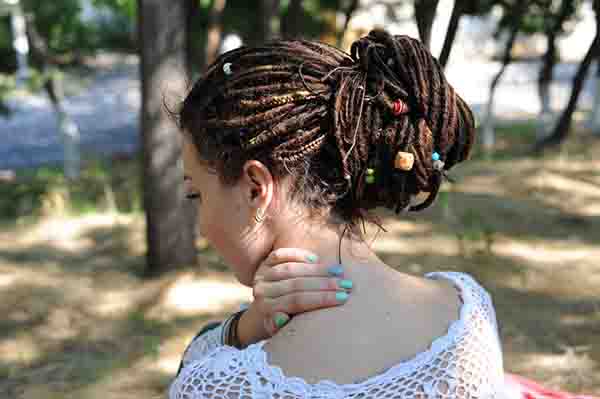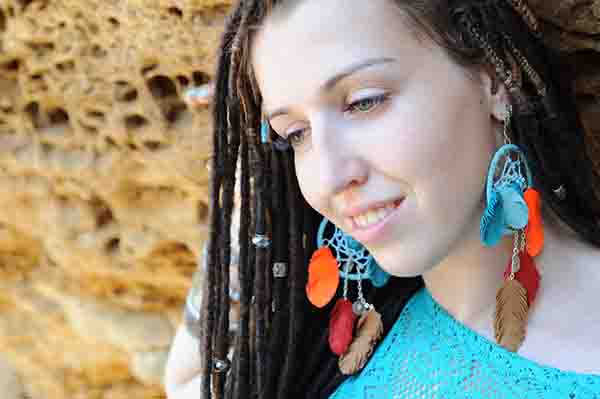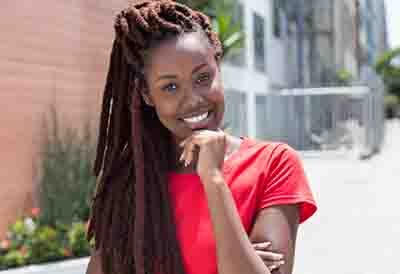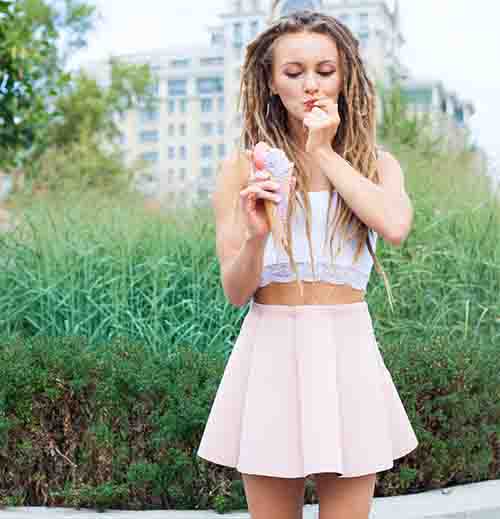Dreadlocks have become a fashion statement, and rightly so. But, are dreadlocks bad for your hair? No, they are not if you do it the right way. Disappointingly enough, most people fall on the bad side of it, like facing gradual hair loss or an itchy scalp.
You need to be intricate about each and every step you undertake in your dreadlock process. It is important to know the factors that are causing you problems but you are constantly allowing them to function. Knowing all the issues will make the interlocking process simpler and doable, ensuring good results.
This article will give you an easy checklist for healthy dreadlocks to properly care for them, and avoid any problems.
How Healthy Are Dreadlocks For The Hair?

Given that you successfully build up dreadlocks, you will enjoy some undermined, but important benefits, that contribute to healthy hair.
These benefits add up to prevent hair damage, severe hair loss, etc.
- Dreadlocks preserve the natural oils on the hair and scalp.
- Long dreads protect from hair fall and keep new hair intact.
- A dread can avoid damage to weak hair and promote natural hair growth.
- Since you can’t blow dry or use chemical dyes on dreadlocks, the cause of extremely damaging your hair is ruled out.
- Unlike other hairstyles, that require frequent wash with shampoos and a conditioner, dreadlocks as a hairstyle are easier to maintain.
Are Dreadlocks Bad For Your Hair?

Most people try to create a dread themselves and end up doing it the wrong way. You can get your dreadlocks done by a professional loctician.
However, if you opt to do it yourself, doing it the wrong way can have a serious impact on your hair.
- Tight and heavy dreads are a direct threat to your natural hair length. Excess stress and product buildup on your hair lead to severe hair fall.
- Your scalp will hurt, as well as the skin in your head region. It will occur the most when the dreadlocks are wet.
- You can suffer from traction alopecia. It is caused your hair is continuously pulled by the dreads leading to bald spots as well.
- Dreadlock extensions will increase the capacity of your hair to absorb matter like dirt, moisture, and chemicals from the air. Your dreads will become weak and smell bad.
- Frequent rinsing with the hope to prevent all the points mentioned above will backfire in the form of hair breakage.
How To Prevent Hair Loss/damage From Dreadlocks?

The key to shielding the hair and scalp from dreadlocks damage is proper maintenance of the dreads. The steps are completely doable and will keep your hairstyle perfectly safe.
So much twisting and styling of your hairs definitely call for some attention.
- Avoid Long Dreadlocks: Avoid too long dreads on your hair . It is fine if you can manage the long dreadlocks, but if you can’t, it is better to not lengthen them.
- Limit Twisting Frequency: Do not go for twisting the dreads at a higher frequency. It can ruin your hairstyle overall. You must take care of this matter, especially if your hair type is thin.
- Optimal Washing: Wash your dreadlocks at an optimum interval. Choose shampoos and conditioners depending on the natural state of your hair.
- Be Cautious with Products: Try not to use products like hair dye as their ingredients can be harsh on your hair. Use products like tea tree oil.
- Reduce Weight on Dreadlocks: Make sure the weight on your dreadlocks is very less. You can do it by not tightening the dreads too much.
- Protect from Breakage: Protect your hair from breakage by covering it with silk scarves while sleeping. Your dreads are already prone to damage, physical weight through friction will only add to it.
7 Things Not To Do With Your Hair Dreadlocks

The section above tells you what to do to protect the dreads. This section will tell you the small details to give attention to.
The following list will mention factors that are not good for your hair dreads. You can undertake measures to address them very easily as part of your hair maintenance practice.
- Dry the dreads with proper blow-drying as soon as you are done getting them washed. Leaving them wet is one of the bad habits of any dreadlock journey. They will smell bad as well.
- Do not trim the loose hair from the roots.
- Avoid using products like wax or gel to style your hair dreads. The use of such products for hairstyles is one of the most common reasons for hair fall and damage.
- Add moisture to your locs. No need to style or twist dry locs, it can put pressure on your scalp.
- No need to invent things at home. Consult a professional person or body to recommend the right treatments for your hair.
- Bleaching is the enemy of your dreads. Many people fall for it, but it is dangerously harmful to your hair and scalp.
- Resist your urge to eat fast food. A healthier diet will contribute to healthier hair locs.
Creating dreads will definitely make your hair go through a lot of pressure. Your hair will have to sustain all of this from its roots, so they better be strong.
Dreadlocks are a time-consuming process, so there is every chance your hair might succumb to the stress. It will test your patience as a person as well.
Note: There is a myth that only curly hair can grow dreadlocks. It is wrong. You can create dreads without curls.
What Happens To Your Hair After Dreadlocks, Does It Harm Natural Hair Or Hamper Hair Growth?
Creating locks on your hair in itself does not impact your hair growth. But it is very easy to get deviated from the right process, as a result, the hair gets damaged. There are many things to do to keep them safe, getting them washed regularly, using the right products, etc.
Given that you are dedicated enough to abide by all of this, your dreadlocks will make you look the best person ever.
How To Keep Dreads Healthy And Growing?
Guard your hair against unwanted attention from your surroundings in the form of pollution. Keep washing them regularly, but don’t overdo it. Use mild products that suit dreads, and use apple cider vinegar whenever you face bad hair days. Stay easy on the treatments. That’s it.
What Is The Difference Between Dreads And Locs?
Locs/Locks is the name of a particular hairstyle, whereas dreads represent an emotion behind it. But both are synonymous with the same style.
Locks is the name given to the style. But dreads bear a cultural significance. When black people had to go through slavery in the past times, their employers termed their hair dreadful.
But since their hair locks up naturally, they flaunt it proudly as their own culture-terming dreadlocks.
Another school of thought is that dreads are the ones that are created using combs. And locks are the ones that tend to occur naturally.
Some people allow their hair to lock up to embrace it as a style.
FAQs
If the dreadlocks are tighter than they should be, then it can lead to traction alopecia, i.e., balding. But it is an extreme thing, dreads generally do not help in balding. Being careful with the tightening completely rules out the possibility of such a situation.
If the wrong products are used, if too much heat is applied, if too many experiments are done, then yes, interlocking can damage hair. But it can’t if there is attention to detail from your side. All the important aspects have been discussed in the article above.
Take a break from the dreadlock journey. Go for a major trim, and later moisturize them with herbal or mild products. Do not opt for anything like hair color during this period.
Yes, you can add extensions or weaves to dreadlocks. You can make them as long as you’d like, and there are many different types of extensions that you can use.
Rinse the locks for a few more minutes than average. Use a mild shampoo, and let it run through the locks. Try not to be harsh with your hands on them. Dry them immediately after washing them.
A minimum length of 6 inches or 15cm is ideal. But too lengthy dreads can cause problems to your locks by sustaining pollution and damage. The longer the dreads are, the longer maintenance they need.
No, faux locks are a different makeover. People get confused between them as the hairstyles look similar. Dreadlocks last for almost a lifetime, but faux locs last for only about a month or just above that.
Go easy with the washing schedule, overwashing is a major reason for itchy scalp. Use a scalp massaging tool if needed. But don’t do the scalp massaging with your hands, they can ruin your hairstyle.
Yes and no, both. Some people consider them the same, some people don’t. There are quite a few thoughts on this. It’s a personal take by everyone on what they want to call it. The hairstyle may be the same, but the way to get that may be different.
Too much tightening of dreads causes thinning of dreadlocks. Overtwisting the dreads increases the weight on the roots which weakens them significantly. Excessive usage of products on them can also be the reason.
Absolutely. Wear them when you want, and take them off when done. In fact, it can protect natural hair from the outside. Synthetic dreads are a great solution for those who want the style but don’t want to go through the work.
Yes. But it does not happen with everyone. Your hair needs to be very thick and long for that, it’s a genetic thing. Besides, you may not be comfortable with leaving your lengths untouched for a long time.
Tea tree or argan oil. Both of these are natural products that can work magic on your head. They are very effective and can easily provide the right nutrients to your dreadlocks to ready them for styling.
Some believe that the Egyptians were the first to wear dreads, while others think that it was the Ethiopians, Hindu Yogis and Sadhus, Islamic Dervishes, or Black warriors.
The average ones, NO. The organic or herbal ones are fine. Most of the dyes available are made of chemicals that are not good for your scalp or length. Some natural ones have arrived in the market, try them out if you want.
Dreads mature over time and usually take around 15-18 months to fully mature. You’ll know they’re mature when they’re nice and tight, and don’t come out easily when you pull on them.
Yes, you can swim with dreadlocks. Just make sure to rinse your dreadlocks with fresh water after swimming to avoid buildup of chlorine and other chemicals.
YES! Durags help to keep your dreads neat and tidy, and can also help to promote healthy growth.
Goddess locs are no more damaging than any other hairstyle. If installed correctly and taken care of properly, goddess locs can be a great way to style your hair without causing damage.
The frequency of retwisting can vary based on factors like hair type, maintenance routine, and personal preference. Generally, it is recommended to retwist every 4-6 weeks to maintain the shape and neatness of the locs.
Dreadlocks do require some maintenance to keep them healthy and looking neat. However, the amount of maintenance required can vary depending on factors like hair type, length, and the stage of the locs.
People with dreadlocks can wash their hair with a residue-free shampoo, making sure to focus on the scalp and avoiding excessive manipulation of the locs. It’s important to thoroughly rinse out the shampoo to prevent buildup and maintain healthy locs.
Some potential benefits of having locs include low maintenance, versatility in styling, reduced need for heat styling, and the ability to promote cultural identity and self-expression.
Dreadlocks can develop an odor due to sweat, dead skin cells, and product buildup. Regular washing and proper maintenance can help prevent and address any unpleasant smells.
Dreadlocks can thicken over time as the hair continues to grow and the locs mature. However, factors like hair type and maintenance routine can also play a role in the thickness of the locs.
The terms “locs” and “dreads” are often used interchangeably, but some people differentiate between the two based on factors like how they are created (naturally or intentionally) and the cultural or spiritual significance associated with them.
Dreadlocks do not prevent hair loss, but they can help protect the hair from damage and breakage that can contribute to hair loss.
Dreadlocks can potentially hold bacteria if not properly maintained and washed. It’s important to regularly wash and care for the locs to prevent any buildup of bacteria.
The choice between dreadlocks and braids is largely a matter of personal preference and depends on factors like lifestyle, desired style, and maintenance routine.
Dreadlocks do not necessarily slow down hair growth, but factors like tension, tightness, and weight of the locs can affect the rate of growth.
Hair can continue to grow with locs, and the length of the locs can vary depending on the desired length and maintenance routine.
Locs do not necessarily grow faster than regular hair, but they can appear to grow faster due to the way the hair strands intertwine and mat together.
The healthiest protective hairstyle for your hair can depend on factors like hair type, personal preference, and maintenance routine. Examples of protective styles include braids, twists, and updos.
Hair thinning can be caused by factors like excessive tension on the hair strands, scalp irritation, or lack of proper hair care and maintenance.
Dreadlocks do not necessarily thicken hair, but they can help protect the hair from damage and breakage that can contribute to thinner-looking hair.
Dreadlocks can thicken over time as the hair continues to grow and the locs mature, but they can also become thinner if not properly maintained or if there is hair loss or breakage.
Not all dreadlocks have bugs, but it is possible for bugs like lice or mites to infest the hair if proper hygiene and maintenance are not practiced.
Dreadlocks can be sanitary if properly maintained and regularly washed. However, they can potentially harbor bacteria or bugs if not properly cared for.
Dreadlocks can potentially grow mold if they are not properly dried or if there is excessive moisture buildup within the locs. Regular washing and proper maintenance can help prevent mold growth.
The white stuff in dreadlocks can be residue from hair products, dead skin cells, or lint that has become trapped within the locs. Regular washing and proper maintenance can help prevent the buildup of white residue.
The purpose of dreadlocks can vary depending on cultural, spiritual, or personal reasons. Some people view dreadlocks as a form of self-expression, while others may see them as a symbol of cultural identity or a way to promote natural hair.
Dreadlocks can fall out naturally if they are not properly maintained or if there is excessive hair breakage or loss. However, regular maintenance and proper care can help prevent premature hair loss or breakage.
Locs themselves are not inherently unhealthy, but improper maintenance or hygiene practices can lead to issues like hair breakage, scalp irritation, or bacterial or fungal infections. Regular washing and proper care can help maintain healthy locs.
Verdict
Getting the dreadlocks done can be difficult, but it will be worth it if it reflects your personality, rough and tough. Anyone with straight or curly hair can take up the hairstyle. All you need is dedication. But, is dreadlocks bad for your hair? Not really. It is just that the wrong maintenance leads to bad effects.

